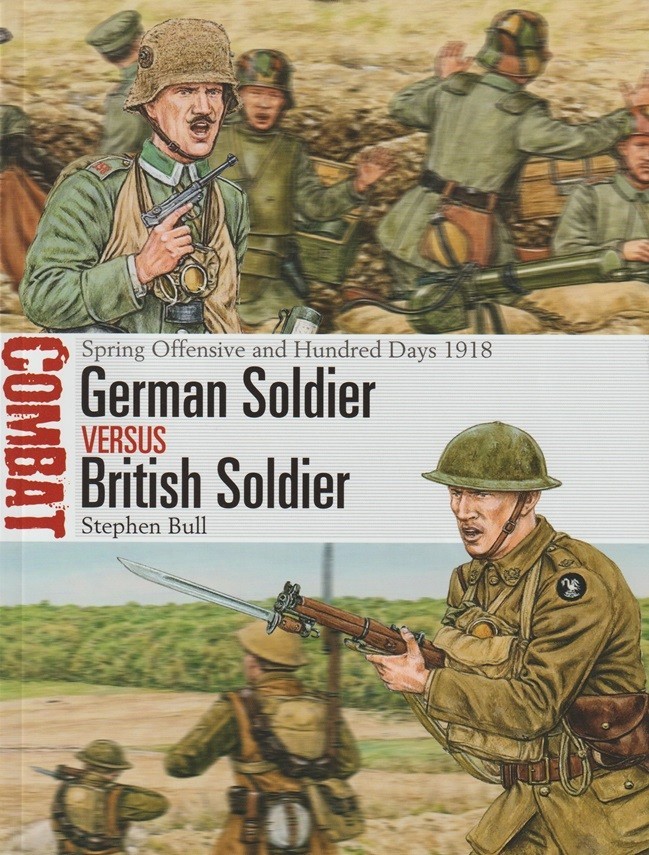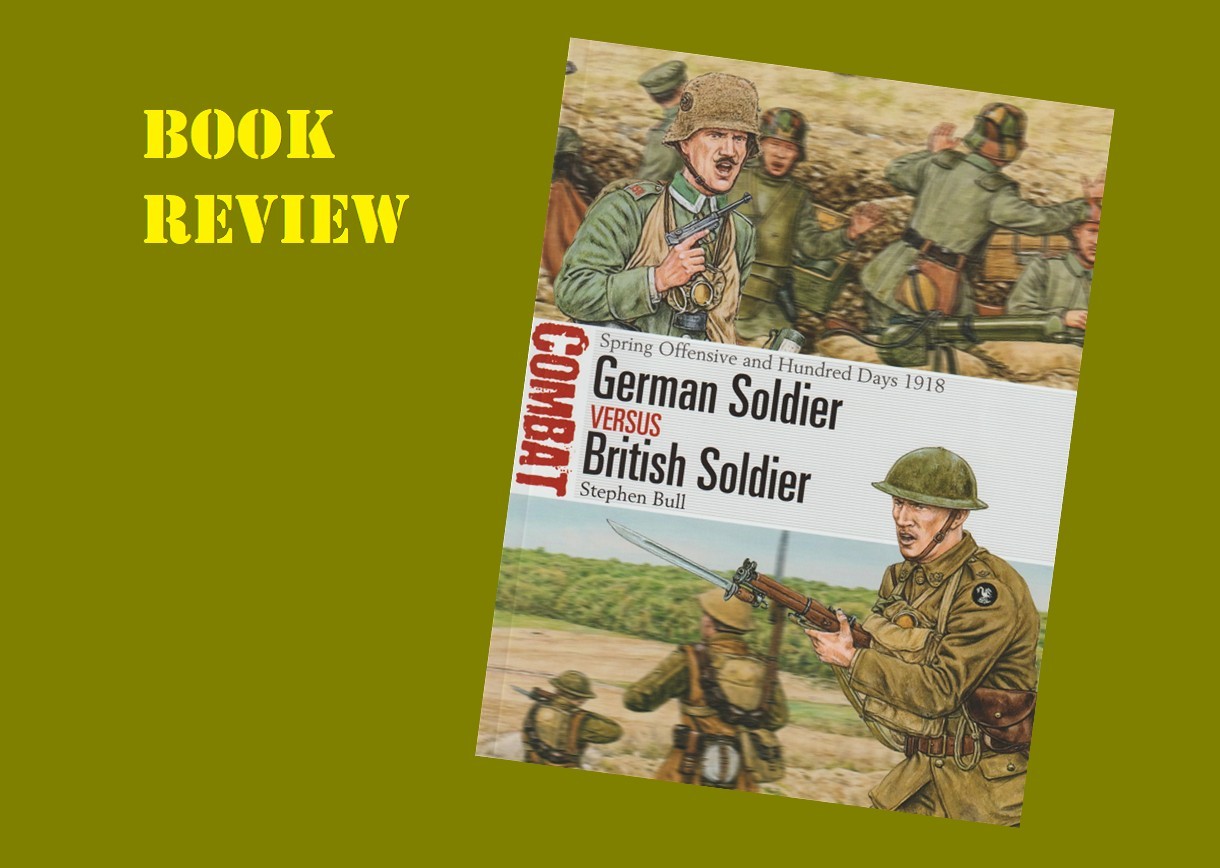
HISTORY:
** Launched on 21 March 1918, the Spring Offensive saw Germany use veteran, highly trained assault troops and innovative assault tactics to encircle and outflank the British and Empire forces manning the front line, hoping to force the French to seek terms and hand victory to Germany. After this attempt stalled, the Allied armies mounted a series of offensives during the so-called 'Hundred Days', actions that pushed the Kaiser's forces back and prompted the demoralized German High Command to sue for peace.
In this fully illustrated book, Stephen Bull shows how both sides fared as the British and their allies survived the Spring Offensive and then went on the attack during the Hundred Days. Three actions – the German assault on Manchester Hill (21 march), the British counter-attack at Rifle Wood (1 April) and a British set-piece attack during the battle of the Selle (20 October) – are examined in detail. Featuring specially commissioned artwork and maps, carefully chosen archive photos and expert analysis and commentary, this study assesses the fighting men on both sides during the climactic months of warfare on the Western Front in 1918. **
** Quoted from the back cover of the book.
THE BOOK:
Osprey Publications has released German Soldier versus British Soldier, Spring Offensive and Hundred Days 1918 as Number 78 in their Combat series. It is a soft cover book with 80 pages and is the standard Osprey Publishing size of 7 1/4 x 9 3/4 inches. Included with the text are black and white photographs and color photographs, color illustrations, detailed captions and more. It has a 2024 copyright, a publication date of August 15, 2024, and the ISBN is 978-1-4728- 6117-7.
THE CONTENTS:
- Introduction
- The Opposing Sides
- Origins and recruitment
- Tactics and training
- Morale, motivation and logistics
- Manchester Hill
- 21 March 1918
- Rifle Wood
- 1 April 1918
- The Selle
- 20 October 1918
- Analysis
- German effectiveness
- British effectiveness
- Aftermath
- Unit Organizations
- Select Bibliography
- Index
THE TEXT:
Author Stephen Bull has written a well detailed history about German and British forces combating each other in 1918 during the Spring Offensive and Hundred Days conflicts at Manchester Hill, Rifle Wood and The Selle. The text goes into very specific detail in all areas of the book as outlined on the contents page, please refer to the contents listing that I have provided for the areas that are covered through the book. The three conflicts listed are greatly detailed with information provided on specific military units and their movements and actions, locations, successful actions, actions that failed, weaponry used, and such other informative information that the reader would expect to find in a well written historical publication. The author details and discusses the specific military units deployed and the actions they were involved in, the time frame of each specific action, and the successes, failures and outcomes of the campaigns. When discussing the individual areas of combat and the actions taken there, the author also provides specifics such as the types of trenches and shell holes and craters used, the types of artillery and specific types of artillery rounds used and the effect of them, the types of small arms each side of the conflict faced, the numbers of wounded, killed and missing soldiers and their military ranks and other such information down to such minute details such as the type of terrain where the fighting took place, visibility restrictions caused by smoke and the weather conditions such as fog. In addition to his own words, Stephen Bull has provided quotes from individuals such as a German soldier from the 3. Garde-Infanterie-Division, Canadian Brigadier-General J.E.B. Seeley, German Hauptmann Freiherr von Falkenstein with the Saxon 2. Grenadier regiment ‘Kaiser Wilhelm’ Nr. 101 and others that were directly involved with the battles. The text in the book is nicely written and well detailed. As I read through the text, I didn’t notice any spelling or grammatical errors. Grammar and spelling might not be an important factor to everyone however it is something that I take notice of and pass on my findings. I feel that if the text is well written then it shows that the author has taken the time to be professional with their writing. I found myself to be well informed upon finishing the book. Anyone wanting to add an excellent reference and history book on the German and British militaries and their combat actions at Manchester Hill, Rifle Wood and The Selle during World War I in 1918 to their personal library will be pleased with this very informative and interesting book.
THE PHOTOGRAPHS:
A total of 48 black and white photographs and 4 color photographs are included in this volume. The photographs range from wide angle photographs to close-up detailed photographs. They are a combination of in-action photographs, photographs removed from motion pictures to photographs that have been staged for the photographer. Most of the photographs are clear and easily viewable; however, a few have an out-of-focus appearance, and some appear to be too dark, and others appear too light. This is typical for the discussed period of history and consideration needs to be given to the fact that most of the photographs are over one hundred years old and the quality of the photographs is of no fault of the author and do not take anything away from the book. The close-up photographs show items such as German and British uniforms to include helmets, soft caps, bandoliers and ammunition pouches, German trench armor and military medals and ribbons. Several military small arms are shown to include handguns, rifles, machine guns, mortars, stick hand grenades, a German anti-tank rifle, bayonets and others. Also shown are artillery pieces and artillery limbers, horses and horse tack, British and German tanks, trench systems and weapon emplacements. Author Stephen Bull stuck to the title of the book and chose subject specific photographs and did not include photographs that strayed from the main subject. The majority, if not all, of the photographs will prove to be excellent reference material for the scale figure modeler as well as the diorama builder due to the details they contain. The military historian, and the military uniform and smalls arms enthusiast will benefit from the excellent photographs as will anyone that is interested in the German and British militaries and the conflicts between the two during World War I.
THE ILLUSTRATIONS:
There are four color illustrations by illustrator Adam Hook provided in this volume. One of the color illustrations is a split-screen illustration and on the following page a black and white copy of the same illustration is included that describes the scene and points out and describes key areas of interest. The illustrations are very well done, nicely detailed and are of:
Plate A
Unteroffizier, Infanterie-Regiment Nr. 158, Manchester Hill, 21 March 1918. (See attached scan)
- Two-page front and back color illustrations of a German ‘shock troop’ NCO with a well written caption that details and points out eighteen items of interest such as weapons, dress, and equipment of the period.
Plate B
Second Lieutenant, 16th Manchester, Manchester Hill, 21 March 1918. (See attached scan)
- Two-page front and back color illustrations of a British junior officer with a well written caption that details and points our thirteen items of interest such as weapons, dress, and equipment of the period.
Plate C
Rifle Wood, 1 April 1918
- A color two-page action double scene depicting the clash between unmounted calvary of the 20th Hussars and German troops entrenched and on the high ground on the edge of Rifle Wood. The two-page illustration provides the view from the British point-of-view (top) and the German’s point-of-view (bottom). On the following page there are detailed captions, which accompany two black and white copies of the same-colored illustrations, with the captions detailing what is taking place in the two scenes.
Plate D
Capturing a machine-gun nest
- A two-page action color illustration showing the incident of 20 October 1918 when officers and enlisted men of the British 5th East Lancashire engage and capture two German machine gun teams in a shell hole armed with two MG 08/15 light machine guns near the British front line. The illustration is shown as the view from one of the British enlisted men and it shows both British and German uniforms, equipment, weapons and other items such as German Sappenpanzer trench armor. On the following page there is a detailed caption detailing what is taking place in the scene.
PROFILES:
There 2 individuals profiled in this volume, and they are:
- Max Bauer
- Max Bauer was a German artillery expert and a key subordinate in the German Supreme Command. He played a role in the Kapp-Putsch and died in Shanghai in 1929 while serving as an economic adviser to Chiang Kai-Shek while also serving clandestinely as a military trainer as well.
- Walter Hall
- A lieutenant commissioned into the 20th Hussars in 1911 when the war started and later reached the rank of Captain and ended the war as a lieutenant-colonel. Hall was later transferred to the Royal Flying Corps as an observer. He was awarded the MC and Bar, and the Croix de Guerre.
THE CAPTIONS:
The captions are well written and explain the accompanying photographs and illustrations in great detail eliminating any doubt as to what is shown. The captions go into very specific detail as to the specific individuals shown and their military rank and military unit they are assigned to, the types of uniforms and accoutrements, weapons, equipment carried and used, types of artillery and armor and other weapons such as machineguns and mortars, dates and locations and other such pertinent information. Stephen Bull’s captions will be very helpful to the reader due to their detailed content as opposed to other captions that I have seen that are very brief and lacking in detail.
MAPS:
There are 4 color maps included in this volume that are accompanied by well written captions and detailed keys that point out specific locations as well as movements and actions by both sides of each conflict.
The maps are of:
- Western Front operations in 1918 (See attached scan)
- Manchester Hill, 21 March 1918
- Rifle Wood, 1 April 1918
- The Selle, 20 October 1918
INFORMATIONAL CHART:
There is 1 chart included in this volume and it is of:
- Key to military symbols
- Key to unit identification
CONCLUSION:
As with the other Osprey Publishing titles I was impressed with this book. This is a very nice reference book that contains a well written informative text, many subject specific photographs and illustrations, well detailed captions and more, all detailing the origins, training, logistics, unit organizations as well as the combat actions between the German and British militaries at Manchester Hill, Rifle Wood and The Selle during World War I in 1918. As with the other Osprey Publishing titles, I have no hesitation recommending this book to others as it will be a welcome addition to one’s personal reference library.
Osprey Publishing also offers Combat - German Soldier versus British Soldier, Spring Offensive and Hundred Days 1918 as:
Ebook (Epub & Mobi) ISBN: 978-1-4728-6118-4
and
Ebook (PDF) ISBN: 978-1-4728-6119-1
Osprey Publishing’s, Combat - German Soldier versus British Soldier, Spring Offensive and Hundred Days 1918 is also available as a Kindle version through Amazon.
PRICE:
UK £15.99 / US $23.00 / CAN $31.00
This book was provided to me by Osprey Publishing. Please be sure to mention that you saw the book reviewed here on the KitMaker Network when you make your purchase. Thank you.

